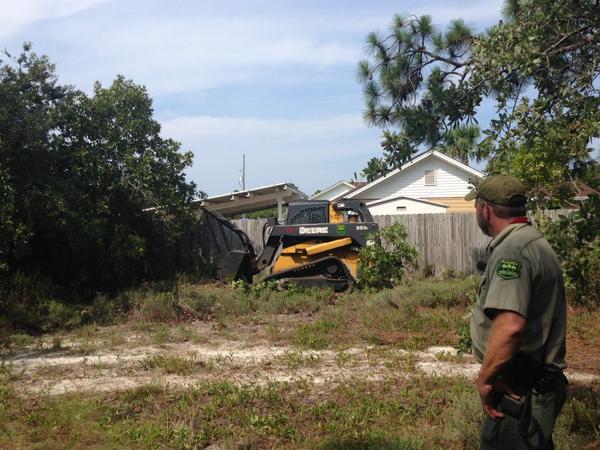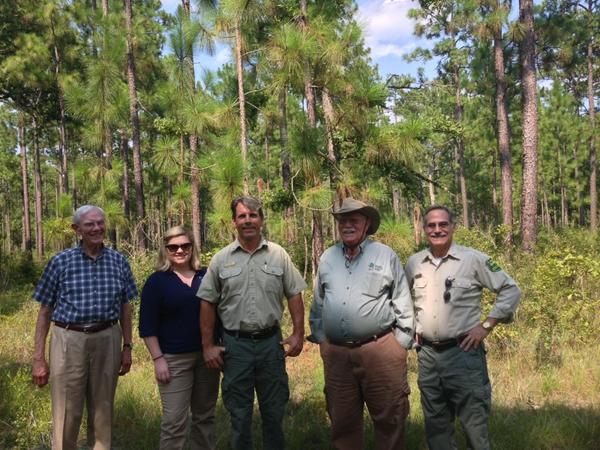Guest post by Leslie Robertson, NASF Photo Fellow
Chelsea and I spent the morning with Hannah Anderson, a wildfire mitigation specialist. Shane McGowan, forest area supervisor for the team, explained that they were pretty short-handed at the moment; many of the firefighters were sent to California to fight wildfires there.
We drove to a private landowner’s property where we were able to observe some mechanical mitigation. We looked over the property, which was thick with brush and small growth at risk for wildfire. I learned that the combination resins, waxes, and oils present in plant life in Florida puts many areas at extremely high risk for burning, even when still green. One plant largely present was the palmetto; it contains special oils and regrows quickly, but it was the “blowy leaf” (that’s the official name!) which made me laugh. However, a smoldering leaf that is easily blown by the wind is no laughing matter.

Forest ranger Randall Davis, Region 1 Wildfire Mitigation Team veteran of seven years, climbed into a skid steer/compact track loader with a mower attachment and began to work his way around the perimeter of the land, right along the fence line. I talked with Shane, and he explained that by lowering the height of the underbrush material, the fires (prescribed burn or otherwise) would burn lower and not cause as much damage to the trees and surrounding area. Also, by targeting the areas close to homes and the edges of the property, the fires can be better contained and pose less risk for neighbors.
Properties like this are usually prescription burned as well as plowed in order to promote healthy regrowth and minimize the risk of wildfire. Just one year ago, human carelessness lead to a wildfire that threatened homes in the area, so with around 50 homes bordering this property alone, the 40-foot buffer zone being created will provide a good level of protection to those homeowners.
In Quincy, we visited the Woodward family tree farm. Brother Bob and Pat Woodward are two of the primary managers of the family’s farmland (they co-own it with their four other sisters). Joining us was Roy Lima, watershed forester and close friend of Bob’s, and John Polak, county forester. The Woodwards have plenty to be proud of; besides having an beautiful, diverse, sustainable tree farm property, they are the recipients of this year’s state Tree Farmer of the Year Award and, finally, are celebrating 100 years of ownership this year as well! We all jumped into Bob’s SUV and we were off on a tour of the property.

One of Bob’s grandchildren described the property as “better than Disney World!”, and I definitely understand why. With a history of being a shade tobacco and dairy farm, the only remaining aspects were some of the original barns and house, left to preserve the past. Gorgeous longleaf stands, once used as fields for cattle, dominated the landscape as we drove through well-maintained grass roads.
Bob emphasized that he was very deliberate in keeping as much of the land natural as possible, evident by the wildlife sanctuaries left untouched within the property for deer, gopher tortoises, and turkeys to live. (In fact, we saw several very healthy looking deer that afternoon.) The Woodwards also have the forests on a two- to three-year rotational management plan, using chemicals and prescribed burn to keep the landscape from becoming overgrown. When the forest is thinned, they leave the strongest trees to seed in order to create better, more healthy trees.
As we chatted, it became clear to me how much Pat and Bob truly respected and cared for the land and how much it meant to them and their family. I felt very fortunate to be able to experience it. We wrapped up the tour by driving through an amazing stand of magnolia trees; I can only imagine the beauty when they are flowering.

